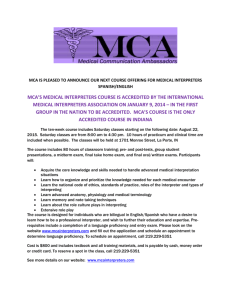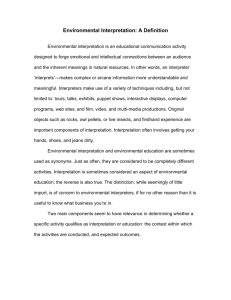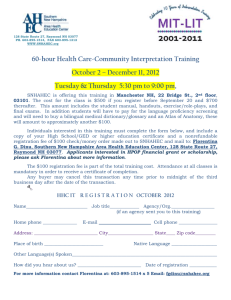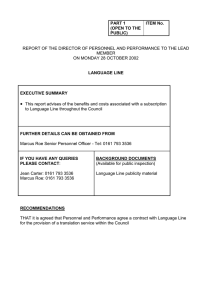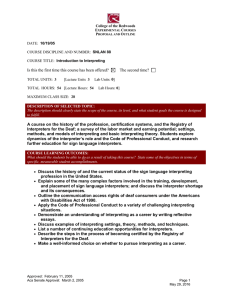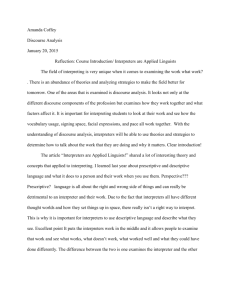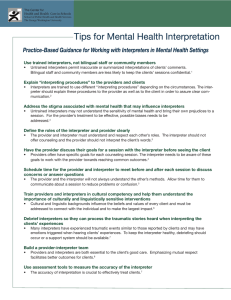PowerPoint Slides - University of Northern Colorado
advertisement
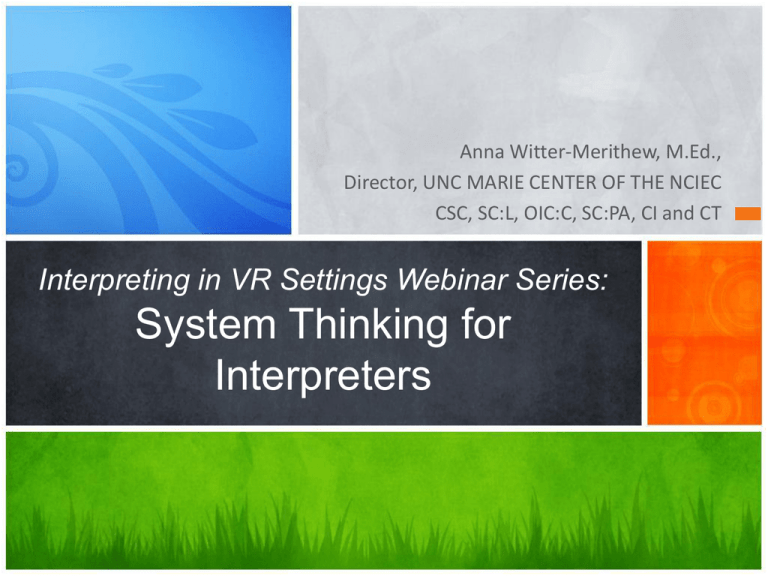
Anna Witter-Merithew, M.Ed., Director, UNC MARIE CENTER OF THE NCIEC CSC, SC:L, OIC:C, SC:PA, CI and CT Interpreting in VR Settings Webinar Series: System Thinking for Interpreters National Center Northeastern University NURIEC WRIEC Northeastern University CATIE Center Western Oregon University El Camino College St. Catherine University GURIEC MARIE Center University of Northern Colorado Gallaudet University Consortium Mission • to connect and collaborate with diverse stakeholders in order to create excellence in interpreting cross-center collaboration technical assistance communication educational opportunities dissemination resources knowledge transfer Outcomes • Introduce participants to a framework for systems thinking • Increase participants appreciation for how systems thinking can contribute to role definition and implementation W E B I N A R Problem Statement: Antagonistic Autonomy Practitioners Members of the System Source of Frustration No one understands my role! No one really understands what I do and how hard it is. Ongoing internal conflict and isolation. Role Perception and Definition Historic Views Emergent Views Equal Footing Doctrine Interpreting as Practice Profession To place Limited English Proficient (LEP) persons on an equal footing with those who understand English Professional work done in the context of human interactions that involves the application of professional practices and professional acts evolved over time and through scholarship Interpreter as Conduit Invisible Non-Intrusive/Non-participatory No more, no less Diffused Responsibility Interpreter as Co-Participant System Thinker Agent of the Court Collaborator Shared Responsibility Impact An interpreter-centric view of our work limits our access to important strategies for • improved relationship building • improved decision-making • greater job satisfaction What is a system? Very simply, a system is a collection of parts (or subsystems) integrated to accomplish an overall goal (a system of people is an organization). Systems range from very simple (mechanical system of riding a bike) to very complex (nature). Different Types We are interested in human systems represented by organizations that are sociopolitical in nature Socio = of society, serving the interests of society Political = negotiated standards, often government regulated, relating to social relationships involving authority or power Human Systems consist of… • People • Structures and • Processes that work together to make an organization function as effectively and efficiently as possible. People • Carry out the processes (procedures, practices, acts) • Typically well trained to carry out the processes in accordance with the particular structure in which they work • Within large systems, the people often change • Changing personnel has significant implications for the effectiveness of the system Structures • The framework, typically hierarchical, within which an organization/system arranges its lines of authority and communications, and allocates rights and duties • Organizational structure determines the manner and extent to which roles, power, and responsibilities are delegated, controlled and coordinated, and how information flows between levels of the system More About Structures • Centralized – The decision-making power is concentrated in the top layer of the management and tight control is exercised over departments/divisions • Decentralized – The decision making power is distributed and departments/divisions/ workers have varying degrees of autonomy Processes • The recognized and approved procedures, policies, practices and acts that allow the people within the system to move forward in implementing the intention of the system • As new standards are developed/adopted, processes can change • Changing processes can impact the predictability of some systems Why important to interpreters? System thinking allows us to identify and interpret patterns and events in systems, to understand the inter-relatedness of the various parts of the system, and to better appreciate the social conditions that exist and impact our work. But, how does this change what we do? Our role is socially constructed because it is embedded in human interactions. Our ability to exercise our decision latitude is relational—it is context-bound and dependent on how we “fit” both conceptually and pragmatically into the system. Role Perception and Definition Historic Views Emergent Views Equal Footing Doctrine Interpreting as Practice Profession To place Limited English Proficient (LEP) persons on an equal footing with those who understand English Professional work done in the context of human interactions that involves the application of professional practices and professional acts evolved over time and through scholarship Interpreter as Conduit Invisible Non-Intrusive/Non-participatory No more, no less Diffused Responsibility Interpreter as Co-Participant System Thinker Agent of the Court Collaborator Shared Responsibility Definitions Professional Practices Professional Acts • Patterns of practice that are exemplified by a practitioner • Distinctive and recurring professional behaviors evolved over time • Reflect the agreed upon norms of professional protocol • Recognized as best or effective practice Two Important System Principles • The system’s overall behavior depends on its entire structure. • A circular relationship exists between the overall system and its parts. System-based authority • Much of the authority interpreters have in the implementation of their role is directly tied to the system in which they work. For example, legal interpreters are designated as Officers of the Court and K-12 interpreters are part of the educational team. Take Away Messages • System Thinking empowers interpreters to recognize that our role is sociallyconstructed, and to find new ways of appreciating and relating to the systems in which they work • System Thinking expands the options (controls) available to an interpreter because the range includes system-based practices and acts in addition to interpreter-centric acts Closing Thought • System Thinking provides us with another way to think about, talk about and approach our work. Doing so shifts our perspective to a more systems/”big-picture” orientation to what we do. • In the next webinar, on Monday, February 24th, we will look at Vocational Rehabilitation as a system and the implications for our work in VR settings. References/Resources Ackoff, Russell L. (2010), Systems Thinking for Curious Managers, Triarchy Press. ISBN 978-09562631-5-5 Bánáthy, Bela. H. (2000) Guided Evolution of Society: A Systems View (Contemporary Systems Thinking), Springer Publications. ISBN 0-306-46382-2 Meadows, Donella (2008), Thinking in Systems - A primer, NY: Earthscan ISBN 978-1-84407-726-7 Senge, Peter (1990), The Fifth Discipline, NY: Currency/Doubleday ISBN 0-385-26095-4 The Consortium Centers are funded by grants from the U.S. Department of Education, Rehabilitation Services Administration, Training of Interpreters Program CFDA 84.160A and 84.160B. Connect with us on www.interpretereducation.org Join our mailing list
